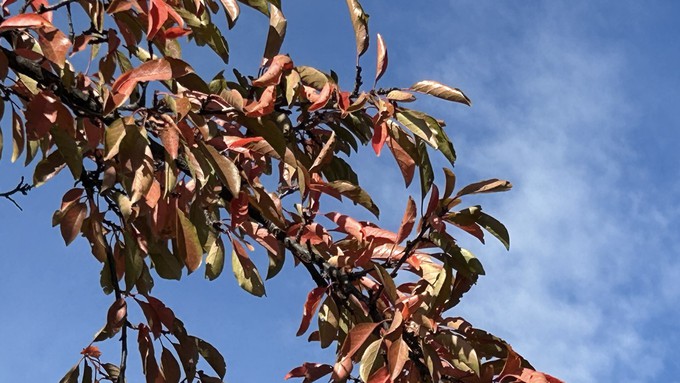
Garden forecast: November starts with real rain, then more warm days

Those colorful leaves overhead will soon be on the ground, ready for raking and scooping. Meanwhile, the blue sky of earlier today will yield to storm clouds tonight. Kathy Morrison
After one of the hottest Octobers on record, it suddenly feels like the appropriate season (at least for a few days).
According to the National Weather Service, a fast-moving storm will give all of Northern California a deep soaking this weekend. By Saturday night, Sacramento is expected to receive .5 to 1 inch of rain (mostly overnight), with more in the foothills. In the Sierra, snow is forecast above 6,000 feet.
By Monday, we’ll be back to sunny skies – and higher temperatures. Sacramento should see afternoon highs in the low to mid 70s throughout the coming week.
That’s actually on the warm side. November in Sacramento averages highs of 64 degrees and lows of 43. As for rain, November starts our soggy season (fingers crossed), averaging just over 2 inches.
It’s a big contrast to our just-completed October, which saw a 35-degree swing in high temperatures (and almost no precipitation). Oct. 1 hit 102 degrees in Sacramento; the high on Halloween was only 67.
Such warm weather prolonged growth on many summer plants. (My remaining tomato vines are still blooming.) Those warm-weather remainders may start fading fast.
With nights now dipping into the 40s, expect to see fall foliage coloring up in a hurry – and leaves starting to come down in bushels. Leaf season has arrived.
In the City of Sacramento, leaf season officially begins Monday with the start of in-street pickup of leaves and garden waste. Before it wraps up in January, residents can expect “The Claw” – the city’s specialized leaf-scooping tractor – to visit your street seven times.
For pick-up schedule in your neighborhood, go to: https://www.cityofsacramento.gov/public-works/recycling-solid-waste/Collectionservices/Leaf_Season
For Sacramento weather updates: https://www.weather.gov/sto/
Comments
0 comments have been posted.Sacramento Digs Gardening to your inbox.
Food in My Back Yard Series
May 6: Maintain soil moisture with mulch for garden success
April 29: What's (already) wrong with my tomato plants?
April 22: Should you stock up on fertilizer? (Yes!)
April 15: Grow culinary herbs in containers
April 8: When to plant summer vegetables
April 1: Don't be fooled by these garden myths
March 25: Fertilizer tips: How to 'feed' your vegetables for healthy growth
March 18: Time to give vegetable seedlings some more space
March 11: Ways to win the fight against weeds
March 4: Potatoes from the garden
Feb. 25: Plant a fruit tree now -- for later
Feb. 18: How to squeeze more food into less space
Feb. 11: When to plant? Consider staggering your transplants
Feb. 4: Starting in seed starting
Sites We Like
Garden Checklist for week of May 11
Make the most of the lower temperatures early in the week. We’ll be back in the 80s by Thursday.
* Plant, plant, plant! It’s prime planting season in the Sacramento area. Time to set out those tomato transplants along with peppers and eggplants. Pinch off any flowers on new transplants to make them concentrate on establishing roots instead of setting premature fruit.
* Direct-seed melons, cucumbers, summer squash, corn, radishes, pumpkins and annual herbs such as basil.
* Harvest cabbage, lettuce, peas and green onions.
* In the flower garden, direct-seed sunflowers, cosmos, salvia, zinnias, marigolds, celosia and asters. (You also can transplant seedlings for many of the same flowers.)
* Plant dahlia tubers.
* Transplant petunias, marigolds and perennial flowers such as astilbe, columbine, coneflowers, coreopsis, dahlias, rudbeckia and verbena.
* Keep an eye out for slugs, snails, earwigs and aphids that want to dine on tender new growth.
* Feed summer bloomers with a balanced fertilizer.
* For continued bloom, cut off spent flowers on roses as well as other flowering plants.
* Add mulch to the garden to maintain moisture. Mulch also cuts down on weeds. But don’t let it mound around the stems or trunks of trees or shrubs. Leave about a 6-inch-to-1-foot circle to avoid crown rot or other problems.
* Remember to weed! Pull those nasties before they set seed.
* Water early in the day and keep seedlings evenly moist.